




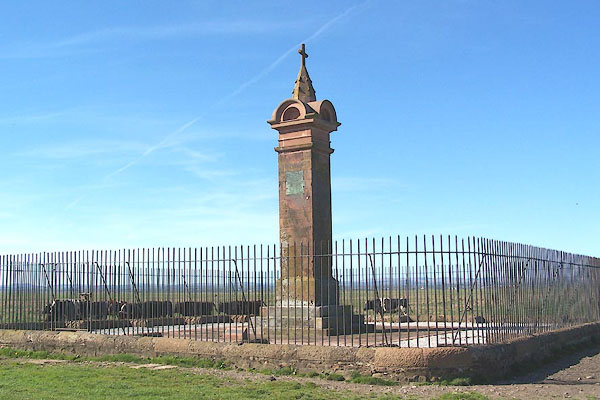
BMA91.jpg (taken 5.5.2006)
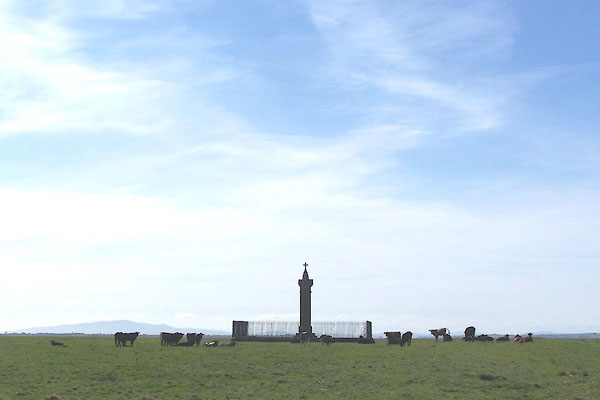
BMA90.jpg (taken 5.5.2006)
placename:- King Edward 1st Monument
 goto source
goto sourcethird page:- "(8) West from hence, at Burgh upon the sand, was the fatal end of our famous Monarch King Edward the first, who there leaving his warres unfinished against Scotland, left his troubles, and soone missed life, to his untimely and soone lamented death."
"... Burgh upon Sands suppos'd to be the same with old Castra Exploratum, memorable on the account of ye renowned K: Ed. 1st. who seduced the Welsh, and marching with his Army against the Scotch dyed here in his Camp 7. July A.D.1307. There is a very fair square Pillar nine Yards &an half in height erected in memory of Him the very spot whereon he expired."
"... no English man, that has any honour in the glorious memory of the greatest and truest hero of all our kings of the English or Saxon race, can go to Carlisle, and not step aside to see the monument to King Edward I. at Burgh upon the Sands, a little way out of the city Carlisle, where that victorious prince dy'd. indeed I cannot wonder that two writers, both Scots, viz. Ridpath and Mr. Kay, should leave it, as it were, not worth their notice, that prince being the terror of Scotland, and the first compleat conqueror of their country, who brought away the sacred stone at Scone Abbey, on which their kings were crowned, also the regalia, and, in a word, made their whole country submit to his victorious arms."
"Near this town, and, as the inhabitants affirm, just on the spot where the king's tent stood in which he expired, for he died in the camp, is erected a pillar of stone near thirty foot high, besides the foundation. On the west side is the following inscription:"
"Memoriae AEternae Edvardi I. Regis Angliae longe Clarissimi, qui in Belli apparatu contra Scotos occupatus. Hic in Castris obiit. 7 Julii, A.D. 1307."
"On the south side:"
"Nobilissimus Princeps Henricus Howard, Dux Norfolciae, Comes Marshal Angliae, Comes Arund. &c. ... ab Edvardo I, Rege Angliae oriundus P. 1685."
"On the north side:"
"Johannes Aglionby, J.C.F. i.e. Juris-consultus fieri fecit. / Tho. Langstone fecit. 1685."
"It is not to be ask'd why Mr. Cambden takes no notice of this because it was not erected till near an hundred years after his survey of the country, only the place was marked by the country people, or perhaps by the soldiers of his army, by a great heap of stones rolled together upon the place; but this monument was erected, as is said above, by a private gentleman, for the eternal memory of a prince, who, when he lived, was the darling of the world, both for virtue and true fame."
 goto source
goto source"..."
"This Town [Burgh by Sands] is yet more memorable for the Mounment of our victorious Prince Edward I. who having so far subdu'd the Scots as to bring away the sacred Stone at Scone Abbey, whereupon their Kings used to be crown'd, died here in his Camp, on his March against them, like a true Soldier, guarding his Frontiers with his latest Breath: In Memory of him there was afterwards erected a handsome square Pillar nine Yards and a half high, with these inscriptions on three Sides:-"
"On the W. Side."
"Memoriae eternae EDWARDI I. Angliae Longe Clarissimi, qui in Belli Apparatu contra Scotos occupatus Hic in Castris Obiit, 7 Julii, A.D. 1307."
"On the N. Side."
"Nobilissimus Princeps HENRICUS HOWARD Dux Norfoliciae, Comes Mareschal, Angliae Oriundus, P. A.D. 1685."
"On the other Side."
"JOHANNES AGLIONBY, I. C. F. C. i.e. Juris consultus fieri causavit."
"Beneath."
"THOMAS LANGSTONE, fecit, 1685"
 goto source
goto sourcePennant's Tour 1773, page 183 "From thence I visited Burgh-marsh, in a parish of the same name, on which Edward I. yielded his last breath, on July 7, 1307, within sight of Scotland, a country he had devoted to the sword for bravely vindicating its own independency. All his steps for some time before his death were marked with cruelty. He condemned to the gibbet persons of the first consideration in the Scottish nation, who had taken arms in behalf of their country, making no distinction between the treasons of natural subjects and the resistance of those who owed him no allegiance, and who preferred the government of one of their countrymen to that of a rival prince. So animated was he against the Scots"
 goto source
goto sourcePennant's Tour 1773, page 184 "that he left Carlisle, in a dying condition, to put himself at the head of his army, and was so weak that he could proceed only six miles in four days. He reached Burgh on the sands, and expired there in the arms of his domestics the morning after his arrival. Thus died the greatest, the best, and the wisest of the English monarchs. All his actions were directed to the good of his own dominions; yet the love of truth must extort the confession, that when the conquest of Scotland became the favourite object of that end, the dictates of equity and the feelings of humanity were totally eradicated."
"Henry duke of Norfolk, in 1685, at that time owner of this barony, erected a square column, with a cross on the top, in memory of this prince. On one side is this brief inscription:"
""Memoriae aeternae
"EDWARDI I. Regis Angliae longe
"clarissimi: qui in belli apparatu
"contra Scotos occupatus, hic
"in castris obiit 7 Julii
"A.D. 1307.""
"On the other side the noble founder of the column by no means forgets his own importance and dignities, nor the blood of all the Howards:"
 goto source
goto sourcePennant's Tour 1773, page 185 ""Nobilissimus Princeps HEN. HOWARD, Dux Norfolc. Com. Marechal Angl. Com. Arundel, Surr. Norfolc. et Norwic. Baro Howard, Mowbray, Seagrave, de Brews, de Gower, Fitz-Alan, Warren, Lescales, Clun, Oswladstre, Maltravers, Furnaval, Graystock, et Howard de Castlerising, Praeno. Ord. Garter Mil. Constab. et Gubernator Regal. Castri et Honor. de Winsor. Dom. Locum-ten. Norfolc. Surr. Berk. at Civit. Com. Civ. Norvici, ab EDWARDO I. Rege Angliae ORIUNDUS.""
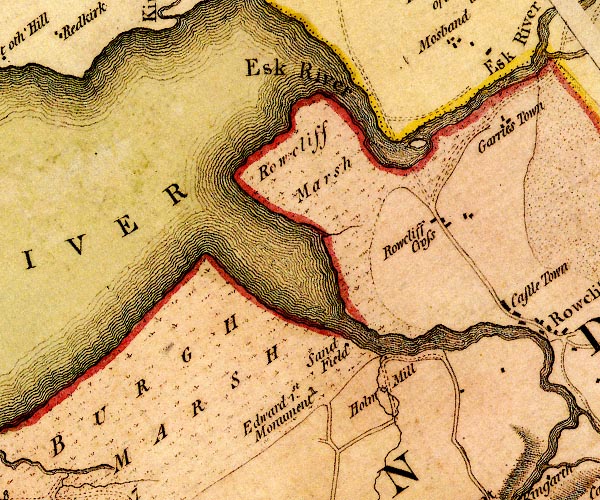
D4NY36SW.jpg
"Edward 1st. Monument"
monument
item:- Carlisle Library : Map 2
Image © Carlisle Library
item:- memorial
 goto source
goto sourcePage 187:- "..."
"... the spot where Edward I died, the memory of which event was preserved by some great stones rolled on it, is erected a handsome square pillar nine yards and an half high with this inscription in Roman capitals on the west side:"
"Memoriae aeternae Edvardi I. regis Angliae longe clarissimi, qui in belli apparatu contra Scotos occupatus hic in castris obiit 7 Julii A.O. 1307."
"On the south,"
"Nobilissimus princeps Henricus Howard dux Norfolciae comes mareshall. Angliae, comes Arund. &c. ... ... ab Edvardo I. rege Angliae oriundus. P. 1685."
"On the north,"
"Johannes Aglionby J.C.F.C. i.e. juris consultus fieri curavit."
placename:- King Edward I Monument
courtesy of English Heritage
"KING EDWARD I MONUMENT / / / BURGH BY SANDS / CARLISLE / CUMBRIA / II[star] / 78262 / NY3257460920"
courtesy of English Heritage
"Monument. 1685 by Thomas or John Longstaff for the Duke of Norfolk and John Aglionby. Red sandstone ashlar. Tall square column on moulded plinth, moulded cornice, shaped cap surmounted by cross. Latin inscription on south side to memory of Edward I, who died in his camp at Burgh by Sands, 7 July 1307; east side inscription giving titles of Henry Howard, Duke of Norfolk and date 1685; west side inscription John Aglionby. Also had inscription, Tho Longstaff, Fecit 1685 (Ms 7/3f191, St Edmund Hall, Oxford). Bronze plaque records restoration by the Earl of Lonsdale 1803 (collapsed, March 1795); further restoration of 1876. For full inscription see W. Hutchinson, History of Cumberland, 1794, vol. 2, p504."
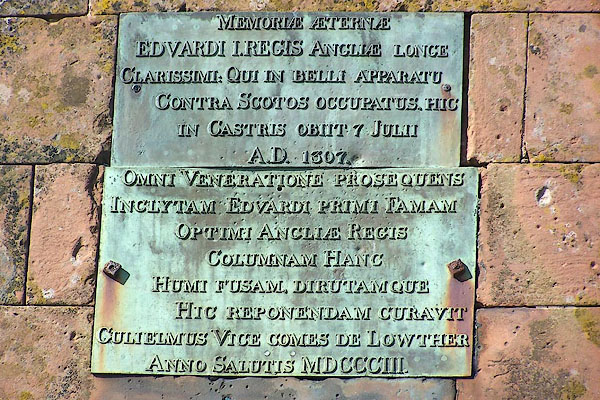
BMA92.jpg Upper:-
"MEMORIAE AETERNAE EDVARDI I REGIS ANGLIAE LONGE CLARISSIMI: QUI IN BELLI APPARATU CONTRA SCOTUS OCCUPATUS. HIC IN CASTRIS OBIIT 7 JULII A.D. 1307" Lower:-
"OMNE VENERATIONE PROSEQUENS INCLYTAM EDVARDI PRIMI FAMAM OPTIMI ANGLIAE REGIS COLUMNAM HANC HUMI FUSAM DIRUTAMQUE HIC REPONENDAM CURAVIT CULIELMIS VICE COMES DE LOWTHER ANNO SALUTIS MDCCCIII." (taken 5.5.2006)
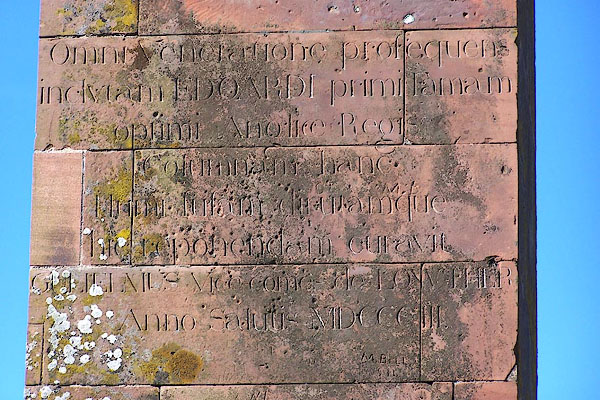
BMA93.jpg Inscription in stone, repeated in the lower bronze plaque.
(taken 5.5.2006)
